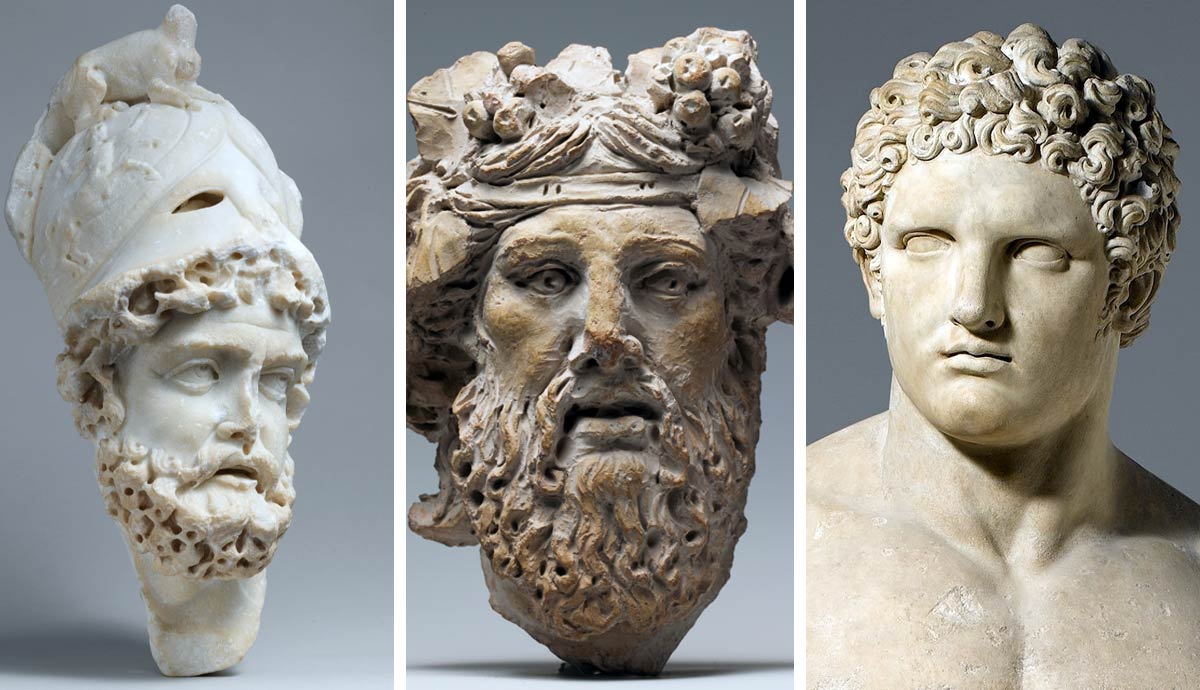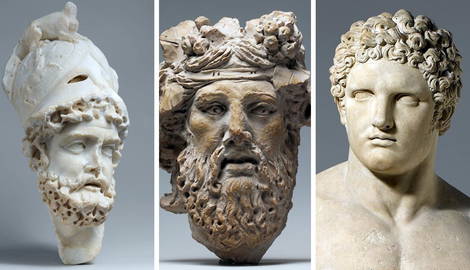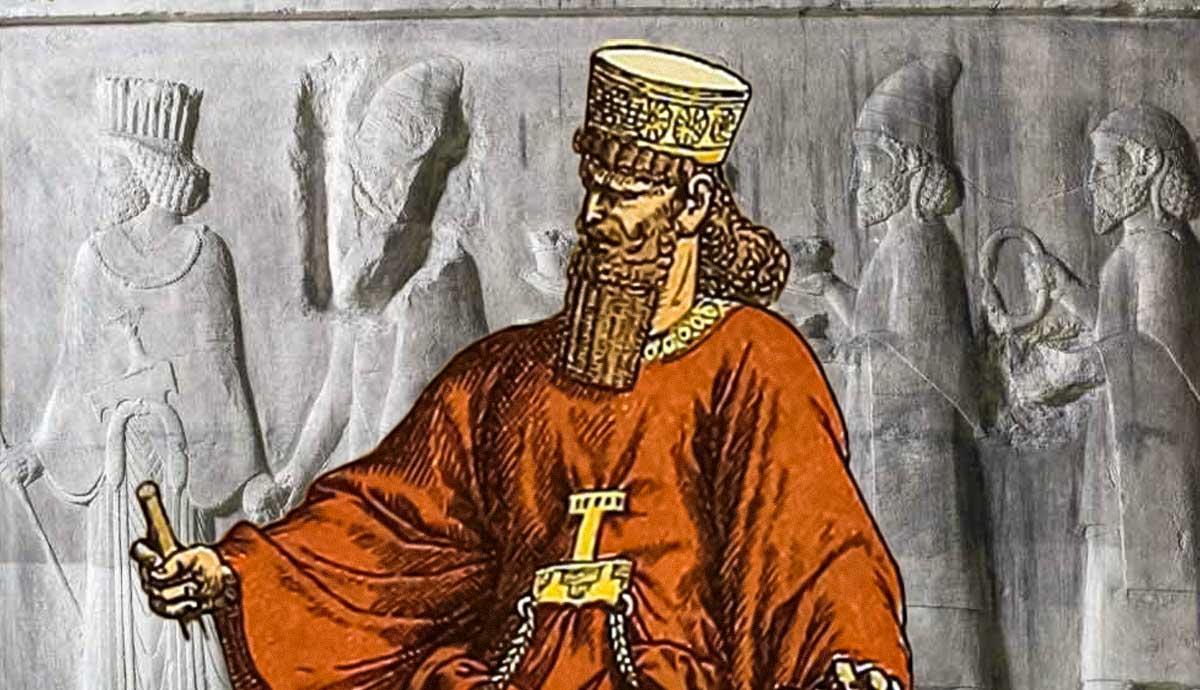
Zeus overthrew his father, Cronos, to become the king of the gods and also had a complicated relationship with his own children. When he received a prophecy that his son with Metis would overthrow him, he tricked the pregnant Metis into turning into a fly and swallowed her. As a result, the goddess Athena was born fully grown from his head. But Zeus, an infamous philanderer, had many other sons, in part to support him in maintaining his position in the Greek cosmos. These are his mightiest sons who played an important role in Greek mythology.
1. Ares: God of War

The earliest source for Ares’ birth is Hesiod’s Theogony, in which he is the only legitimate son of Zeus and Hera. A fragment from Aeschylus gives Ares the same parentage. Ares was the god of war, but unlike his sister Athena, who represented a more strategic aspect of war, Ares represented battle frenzy. Nevertheless, in most myths, he was pitted against a god or a hero and soundly defeated.
Ares was also known for his affair with the goddess of love, Aphrodite. Since Aphrodite was married, they met in secret, but their affair was discovered by the sun god Helios, who told Hephaestus, Aphrodite’s husband. Hephaestus laid a trap for the two lovers, crafting a thin net of unbreakable bronze and laying it above his bed. When Ares and Aphrodite next went to bed, he sprung the trap and captured them. He then invited all the other gods of Olympus to come and shame them. Poseidon convinced Hephaestus to let them go, and Ares fled to Thrace.
2. Apollo: God of Art, Archery, and Light

Apollo was the son of Zeus and the Titan goddess Leto. Hesiod’s Theogony says that Leto was Zeus’ sixth wife before he married Hera, but the common story is that he was already married to Hera when he had an affair with Leto. Hera was known for her jealous wrath against Zeus’ mistresses and set her sights on Leto. Callimachus wrote that Hera was especially angry with Leto because she gave birth to a son more beloved than Ares. Hera prevented Leto from giving birth and sent Ares to threaten any city that offered to take her in, forcing Leto to painfully hold off the birth. She eventually managed to stop at the island of Delos, where she was able to give birth to Apollo and his twin sister Artemis.
Apollo was an oracular god who slew the serpent Python, a son of Gaia who guarded the shrine at Delphi. Python was fated to die at the hands of one of Leto’s children, so when he discovered that Leto was pregnant he tried to kill her. Four days after Apollo was born he went to Delphi and killed the serpent, earning himself the epithet of Pythian and taking over the shrine at Delphi.
3. Hermes: Messenger of the Gods

Hermes was the son of Zeus and the nymph Maia, the daughter of Atlas. According to the Homeric Hymn to Hermes, Maia was a shy goddess who spent most of her time away from the other gods. One night, after Hera went to sleep, Zeus visited Maia in a cave in Kyllene, where they had an affair. She became pregnant and later gave birth to Hermes.
Hermes was best known as the messenger god but also a trickster. As soon as he was born, he had the desire to steal the cattle of Apollo. He made his way to Pieria and stole 50 of the livestock, driving them away and wiping away their hoof prints as he went. He also reversed the tracks in places to make it seem like they were headed in the opposite direction. He also wore adult sandals to cover his identity. An old man saw Hermes with the cattle, but Hermes told the man to forget what he saw and not tell a soul.
Apollo came looking for his cattle and found the man, who told him that he saw a child driving the cattle away. Apollo eventually found his way to the cave where Maia and Hermes were staying. He confronted Hermes, who told him that he didn’t know what happened to the cattle and that he couldn’t possibly have taken them since he was just a baby. The two gods argued back and forth until Zeus intervened. He thought the spat between his sons was entertaining and told Hermes to return the cattle to Apollo.
4. Zagreus: Orphean God

According to Orphic tradition, Zagreus was the son of Zeus by Persephone and an older incarnation of Dionysus. Zeus disguised himself as a serpent and seduced Persephone. She gave birth to Zagreus, whom Zeus pronounced his heir, placing him on the throne of Olympus and giving him the lightning bolt. However, as with most of Zeus’ children, Hera resented him and conspired with the Titans to kill him. The Titans snuck up to Olympus and lured the child Zagreus into a trap with toys. While he was distracted by a mirror they tore him to pieces, boiled him, and ate him. All except his heart, which Athena saved and brought back to Zeus.
When Zeus learned of his son’s death, he flew into a rage, warring against the Titans and striking them down with his thunderbolt. From the ashes, he made another generation of humans. According to Nonnus’ Dionysiaca, this is when Zeus imprisoned the Titans in Tartarus and punished Gaia, mother of the Titans, by setting the world on fire. When he finally calmed down, he covered the sky in clouds and flooded the world. Using Zagreus’ remains, Zeus then brought him back to life through the mortal woman Semele, as Dionysus.
5. Dionysus: God of Joy

In the common tradition, Dionysus was an Olympian god born from a mortal woman, Semele, but the circumstances of his birth were unique in that he was also born from Zeus himself. Due to Hera’s machinations, Semele made Zeus swear an oath on the waters of Styx that he would give her any gift she wanted. She asked that he reveal himself to her in the same form that he appears to his wife, Hera. Knowing the consequence but unable to refuse, Zeus appeared to Semele in his divine form, flashing lightning and blazing in fire, causing her to die of fright.
When Semele was on her funeral pyre, Zeus realized that she was pregnant, so he removed the fetus from her and stitched it to his thigh. When the child, Dionysus, developed and was ready to be born, Zeus removed the stitching. This is why Dionysus was given the title Twice-Born. He became the joyful god of wine, festivity, and madness.
6. Perseus: Monster Slayer

Perseus was the son of the princess of Argos, Danae. He was one of the most famed heroes in Greek mythology, responsible for killing Medusa and saving the Ethiopian princess Andromeda. Perseus was given the task of killing Medusa by the ruler of Seriphos, Polydectes, who wanted to sleep with Perseus’ mother but needed Perseus out of the way. With the help of Hermes and Athena, Perseus was able to learn Medusa’s location as well as acquire the tools needed to sneak up and kill her. Using the helmet of Hades to remain invisible, Perseus snuck up on the Gorgon while she was sleeping and beheaded her.
On his return journey, Perseus stopped in Ethiopia, where he came upon the princess Andromeda laid out for sacrifice for the sea monster Ketos. Andromeda’s mother, Cassiopeia, said that she was more beautiful than all the daughters of the sea god Nereus. This angered Poseidon, who sent a flood and the sea monster to terrorize the land. The oracle of Ammon prophesied that the only way to ease Poseidon’s anger was to sacrifice Andromeda to the monster. When Perseus arrived, he fell in love with Andromeda as soon as he saw her. He swore to kill the monster in return for her hand in marriage. The Ethiopian king agreed, and Perseus slew Ketos and rescued Andromeda.
7. Pirithous: Cursed by Hubris

Pirithous was the son of Zeus and Dia, the second wife of the Thracian king Phineus. Pirithous was a close friend of Theseus. The two heroes made a pact that they would each marry a daughter of Zeus, and Pirithous decided that he would try to seduce Persephone, queen of the underworld and wife of Hades.
They went down into the underworld, braving the dangers until they reached the House of Hades. Hades invited them inside for a feast and told them to take a seat on some stone chairs, but when they did they became stuck and bound by coils of snakes. The god had known of their plan, so as punishment for Pirithous’ hubris, he kept him imprisoned in the underworld. Theseus was eventually saved by Heracles, but Hades did not allow Pirithous to be saved, keeping him trapped forever.
8. Heracles: The Hero

Heracles was a descendant of Perseus and the son of Alcmene, queen of Tiryns. Zeus disguised himself as her husband while he was away at war in order to trick Alcmene into having an affair with him. She became pregnant with Heracles. Zeus then decreed that the next child born to the line of Perseus would be the king of Mycenae. To foil Zeus’ plans, Hera delayed Heracles’ birth so that his cousin, Eurystheus, was born first. This is the Eurystheus that gave Heracles his famed Twelve Labors.
The first of his Labors was to slay the Nemean lion. When he found the beast, he shot at it with arrows, only to discover that its hide was impenetrable. Heracles forced the lion to return to its cave and blocked off one of the two entrances. He then entered the other and attacked the lion with his club, stunning it. Heracles wrestled it to the ground and strangled it with his bare hands. He then used one of the lion’s own claws to skin it and turn its hide into armor. Returning to Eurystheus, the king was so terrified of Heracles that he forbade him from entering the city and told him that he would need to display the fruits of his labors from outside the city walls.
This was the first of many incredible feats achieved by Heracles, who even helped the gods in their war against the giants and was eventually given a place on Mount Olympus.
9. Minos: King of Crete

Minos was the king of Crete and the son of Europa, a Phoenician princess who caught the eye of Zeus. Zeus disguised himself as a magnificent white bull and abducted Europa, bringing her to Crete where he impregnated her. There she gave birth to three sons, Minos, Sarpedon, and Rhadamanthys. After her abduction to Crete, Europa married King Asterios. But when the king died without any sons, Minos claimed the kingship.
To prove he had the blessing of the gods, Minos claimed that anything he prayed for would come to pass. He claimed that a bull would appear from the sea, and he promised to sacrifice it when it did. Poseidon heard his prayers and obliged. Minos became the king, but instead of sacrificing the bull, he kept it in his own herds and sacrificed a different one. Poseidon, however, wasn’t fooled. As punishment, he instilled in Minos’ wife, Pasiphae, a lust for the animal. She had the architect, Daedalus, construct a wooden cow that she could climb into. The bull mistook the construction for a genuine cow and mounted it, impregnating Pasiphae. She then gave birth to the half-bull half-man creature known as the Minotaur.
10. Sarpedon: Warrior of Lycia

Sarpedon was the brother of Minos, but he was driven out of Crete when Minos took the throne, landing in Lycia. The Iliad, however, cites Sarpedon as the son of Laodameia, not Europa. During the Trojan War, Sarpedon fought on the side of the Trojans. He met Patroclus in battle and Zeus contemplated whether he should spare Sarpedon from death even though he was fated to die. Hera reminded him that if he saved his own son from his fate, some of the other gods might think to do the same. So Zeus let his son die and had Death carry him off back to Lycia.










